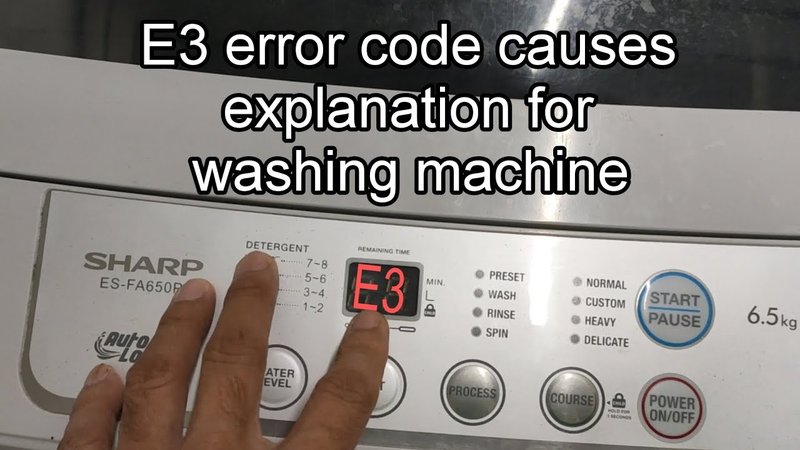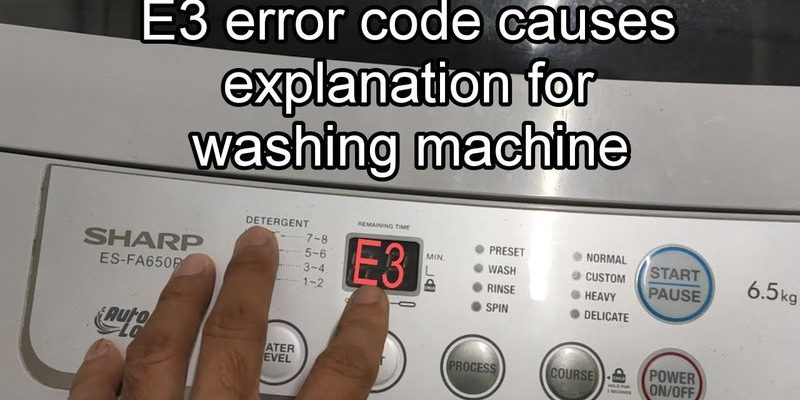
Understanding the E3 Error Code
The E3 error code typically indicates an issue related to the motor or the drum’s ability to spin properly. Think of your washing machine’s drum as a giant salad spinner—when it’s overloaded or unbalanced, it struggles to do its job effectively. This error is your washer’s way of telling you, “Hey, I can’t spin like this!”
One of the most straightforward causes is an unbalanced load. If you’ve stuffed your machine with too many clothes or an unevenly distributed load, the drum can’t spin as it should. Imagine trying to twirl with a heavy backpack on one shoulder—it just doesn’t work well. When this happens, your washer’s sensors detect trouble and throw the E3 code to catch your attention.
Here’s another angle: the problem might not just be with the load but with the motor itself. Sometimes, a failing or strained motor can’t handle the demands placed on it, much like an overworked athlete cramping mid-race. Electrical or mechanical issues within the motor can trigger the E3 error, needing a bit more technical expertise to address.
Common Causes of the E3 Error
The most common culprit behind the E3 error is indeed an overloaded drum. When you pile too many clothes into the washer, it can’t spin freely, generating extra stress on the motor and preventing optimal performance. Imagine trying to walk briskly through a crowded subway car—you’re bound to encounter some resistance.
Another frequent issue is an unbalanced load. If your clothes have formed a heavy ball on one side of the drum, it disrupts the rotational balance. Just as with a wonky shopping cart wheel, the drum struggles to spin evenly, and this mismatch triggers the E3 code. The lesson here? Balance is key.
Lastly, issues with the motor can also lead to an E3 error. A motor that’s been overworked or has electrical issues may not provide the necessary power for the drum to spin properly. This scenario is akin to trying to rev an engine with a faulty gas pedal—there’s just no juice left. In such cases, professional intervention might be required to either repair or replace the motor.
Troubleshooting the E3 Error
So, what do you do when an E3 error pops up? First off, take a deep breath. Addressing this issue often starts with unloading the washer. Remove some of the clothes, especially if they seem unevenly distributed, and see if the error clears. Think of it as letting your washing machine take a breather.
Next, double-check the distribution of your load. Ensuring that items are evenly spread out can make a world of difference. This is similar to packing a suitcase—items should be placed in a way that balances the weight.
If you’re still getting the E3 message after balancing the load, turn your focus to the motor. Here’s the deal: it might be time to call in a professional. They can evaluate your motor’s condition and suggest whether a repair or replacement is needed. Consider this like calling in a mechanic to check your car’s engine.
Preventing the E3 Error in the Future
Prevention is always better than cure, right? To avoid E3 errors in the future, ensure that you’re not overloading the washer. Stick to the recommended load weights provided in your user manual. Think of it as adhering to a diet—everything works better in moderation.
Also, try to balance your loads before starting a cycle. Distribute clothes evenly around the drum, much like setting a balanced meal on a plate. Practice makes perfect, so don’t worry if this takes some time to master.
Finally, if your washing machine is prone to this error due to mechanical issues, regular maintenance can prevent bigger problems. Just like a car, your washing machine will run better with occasional tune-ups. Schedule regular service checks to keep your appliance running smoothly, extending its lifespan and reducing the risk of annoying E3 errors.
In conclusion, understanding and addressing the E3 error code doesn’t have to be daunting. With a little care and attention, you can keep your GE washing machine happy and working efficiently. If the problem persists, don’t hesitate to reach out for professional help—after all, you’re not alone in this laundry journey!
